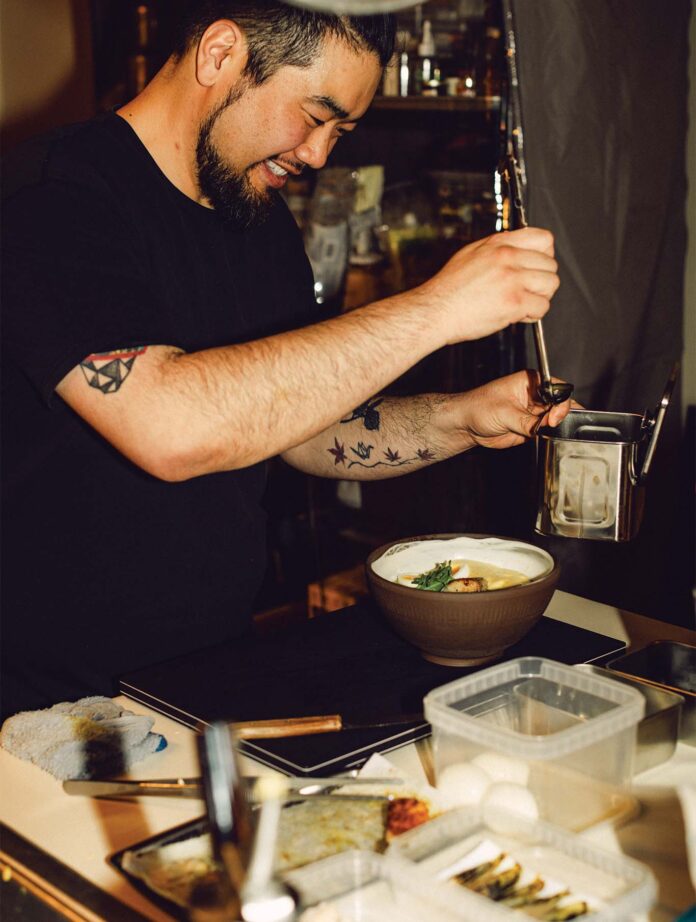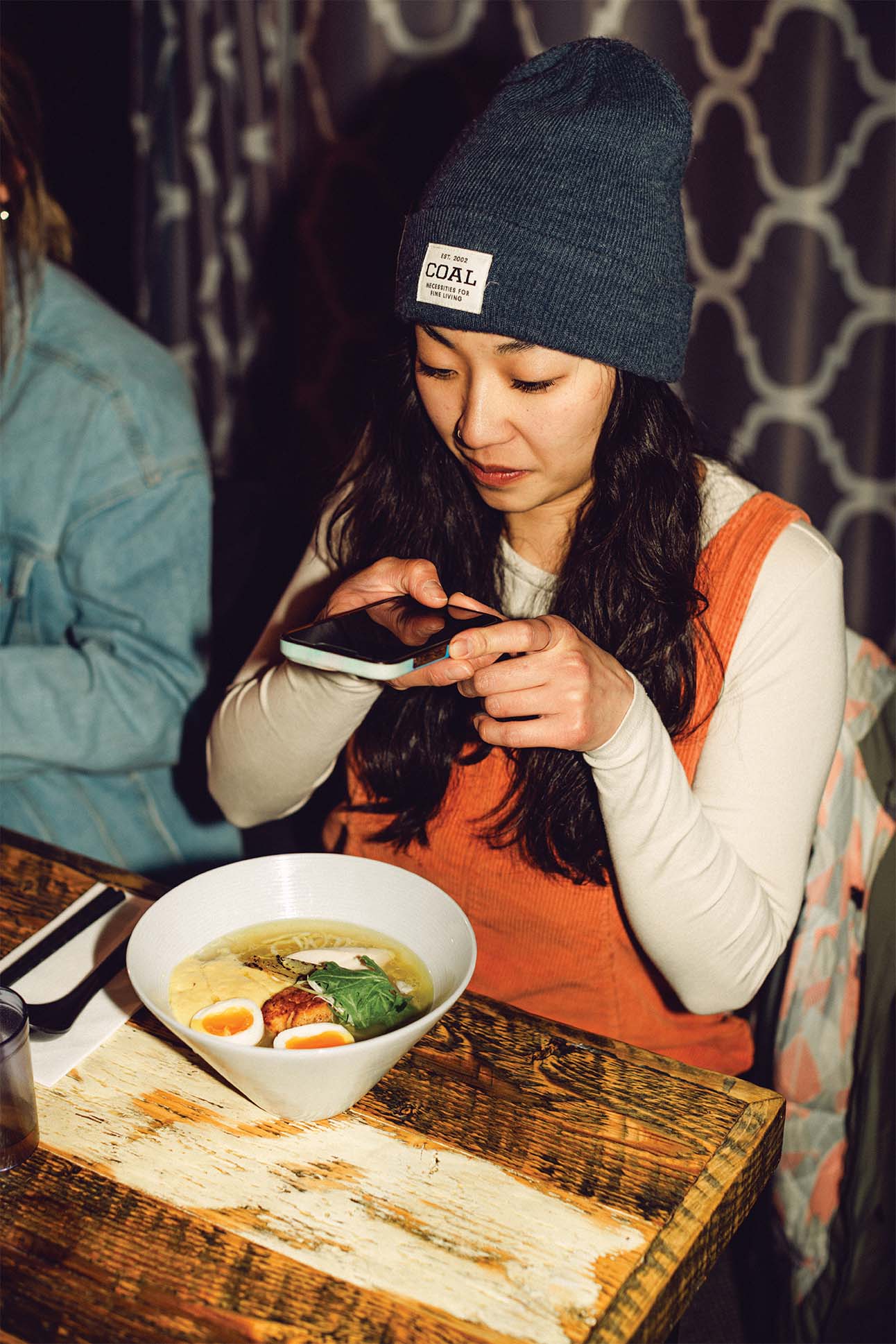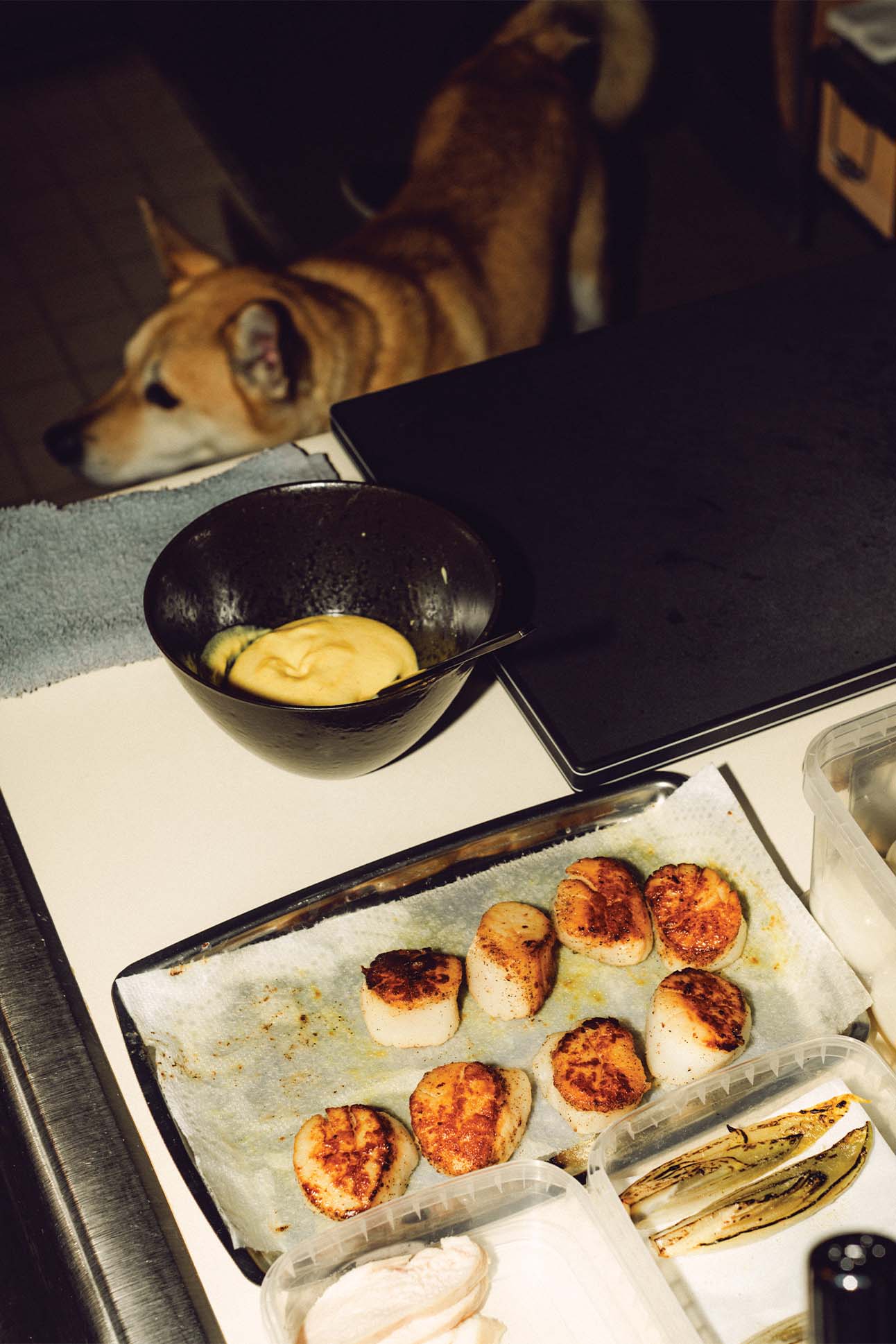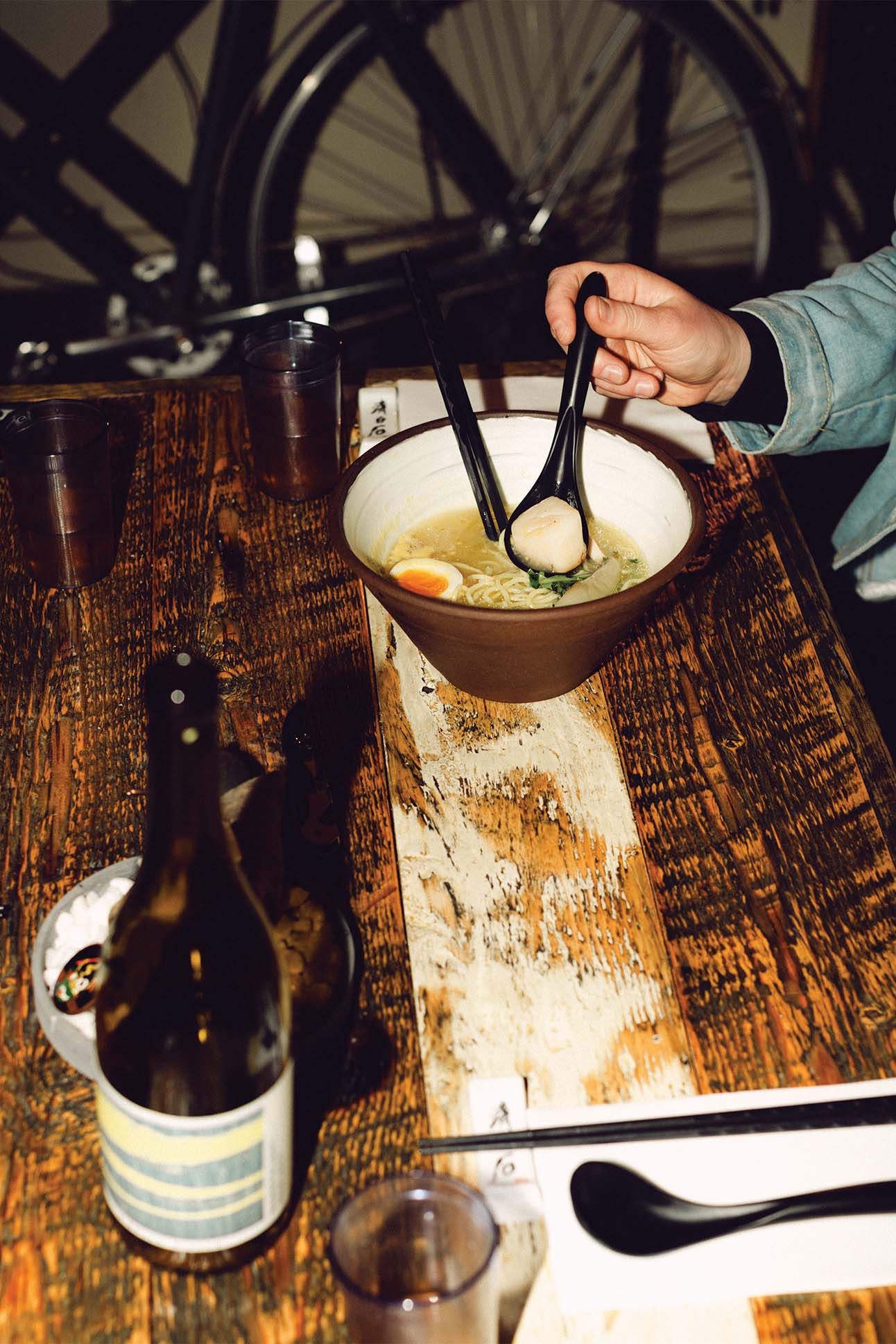Text by Amanda Rae
Images by Tanya Martineau and Trevor Triano
When the massive stoneware bowl hits the table, I catch a whiff of the faraway sea. One perfectly plump scallop, seared and glistening, bobs atop a tangle of fresh ramen noodles in a pool of pale golden broth. Nestled on the surface is a slim wedge of chrysanthemum tea-braised endive with charred edges; a few leaves of razor-edged mizuna and fluffy, diamond-cut green onion; and a soft-cooked egg, halved to reveal a dandelion-yellow yolk. Most curious of all, though, is the dollop of straw-colored froth that covers slices of sous-vide chicken breast in a tidy blanket.
“It’s miso-corn espuma,” says chef David Wang, using the Spanish term for “foam.” “You’ll notice the ajitama (ramen egg) this time is a lot whiter because I used a white shoyu marinade to balance the aesthetics of the bowl. On top, a floater of scallop oil mixed with yuzu.”
We’re dining at Aspen’s most intimate venue, home to the latest iteration of Wang’s clandestine “ramen club”: his studio apartment. The neat space is decorated accordingly—a neon sign depicts chopsticks hovering over a bowl of noodles; a framed certificate from Tokyo’s renowned Rajuku ramen school recalls the two-week master class Wang completed in 2023. A wooden table is set for four and Japanese hip-hop fills the room.
The masterpiece before me, which follows a formula of layering broth, aroma oil, seasoning, noodles, and toppings that dates to ramen’s origins in 1910 Japan, represents nearly three days’ worth of work. The broth is a “quadruple threat,” Wang shares. “A 12-hour, minimalistic chicken broth, mizudorikei—which translates to ‘water chicken style’—is mixed with clam broth cooked 25 minutes, scallop broth cooked for 30, and dashi cooked for 15, all separately because they have different glutamate indexes that peak at different times. If you throw everything in a pot and cook it, you lose all the nuances.”
Thomas Shires, a six-year Aspen transplant by way of Dallas, Texas, lifts his face from the bowl. “The corn thing is brilliant,” he quips between slurps.
I want it to be rebellious, geeky, genuine, and intentional. There are so many ramen spots in this country that serve a soup stock concentrate, just add water.
—Chef David Wang, on the art of ramen

“You see butter, corn, scallops all the time,” says Wang, who emigrated from Taiwan with his parents before age 2 and grew up in Orange County, California. “Culinary Institute [of America] was largely French training. I’ve been studying Latin cuisine, Japanese, Korean, Chinese, Hong Kong, Taiwanese, practicing and experimenting. Now I’m at a point in my career that I can intentionally start blending them together with respect. I’m not mashing stuff together for the sake of it.”
When Wang began hosting communal dinners on his building’s rooftop in 2017, calling the word-of-mouth series Umami Underground, the meals focused on tonkotsu, or pork bone broth—popular with Americans, he notes, because the liquid is rich and creamy with emulsified fat, thanks to aggressive boiling. Wang’s mission from the beginning: to change perceptions around the dish in a “fun, exciting, almost secretive” setting.
“Ramen is not just this quick, easy, cheap throwaway item,” he explains. “There’s a spectrum of styles, flavors, schools of thought. I want people to be able to tell the difference between from-scratch ramen and the sandbagging, cheap stuff that a lot of places sling for a quick buck.”
Once demand for the rooftop parties exceeded physical limitations, Wang launched several ramen pop-ups and kitchen takeovers at local restaurants. Meat & Cheese owner Wendy Mitchell invited Wang back to his old stomping grounds in 2018. (He was executive chef at Meat & Cheese from its opening in 2014 until 2017.) The 200-seat event sold out almost immediately. However, Wang was “head down in the kitchen the whole time,” evaporating any chance at meaningful, educational dialogue. “People showed up, but they weren’t necessarily into it enough to finish their food,” he says. “That’s the culture of this town: Sometimes it’s not about the food or quality. It’s going out to be seen.”
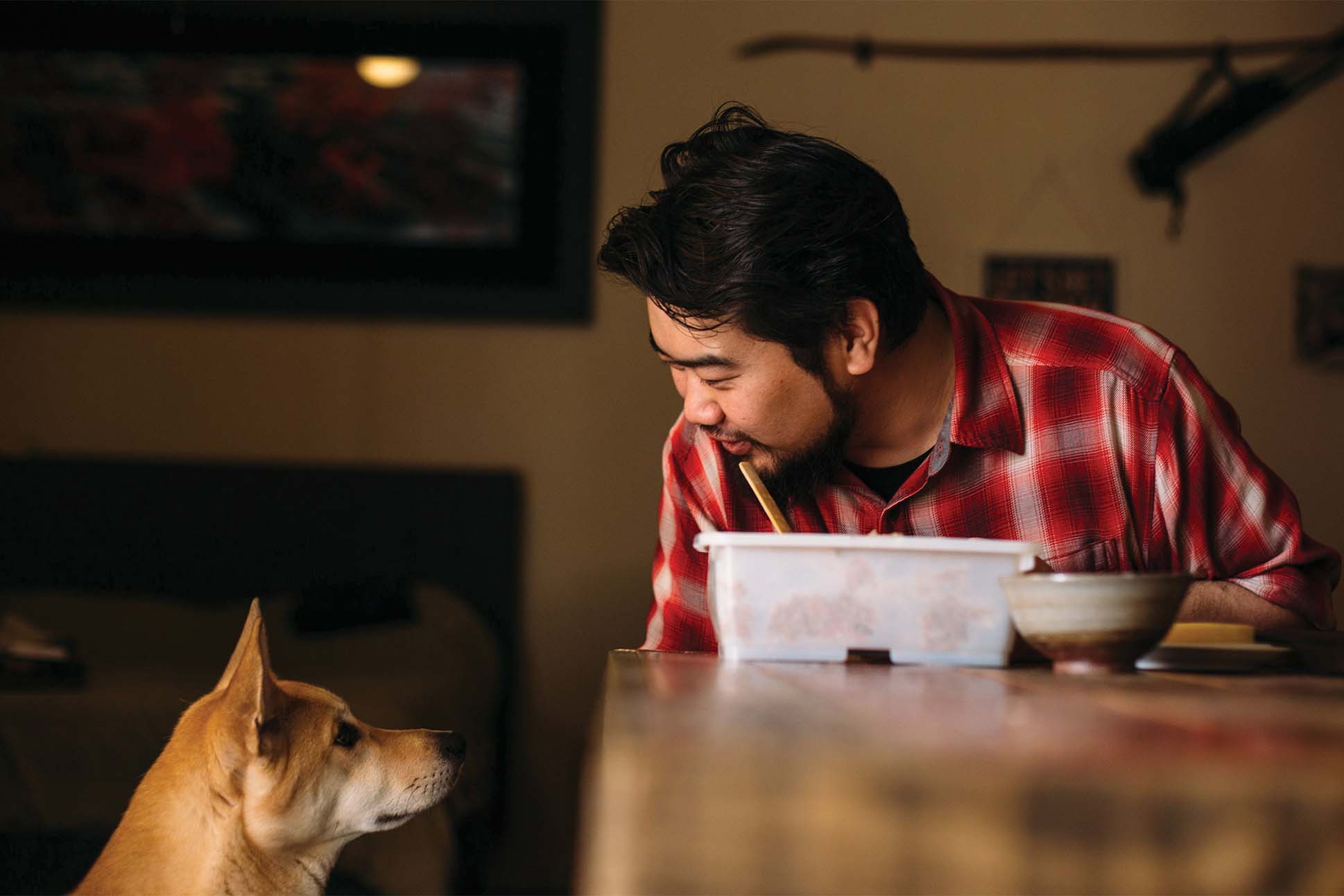

In 2021, once group gatherings resumed post-pandemic, Wang held small tastings in his apartment, typically drawing about 40 people over two nights. He began experimenting with taste memories and new techniques, then he traveled to Tokyo for the intensive ramen course at the Rajuku school, his fourth trip to Japan. Founded by 40-year veteran chef Takeshi Koitani, the institution has turned out apprentices that have gone on to earn high accolades worldwide. Wang’s longtime inspiration, Orange County-based Ramen Shack founder and Ramen Burger creator Keizo Shimamoto, developed his own cooking style under Koitani’s mentorship.
“One of the first operation days, I got assigned to the soup station—literally, to heat up soup and pour it into a bowl,” Wang says. “Within five minutes, I got corrected on the way you hold the ladle, the way you pour it into the bowl. [Koitani] would splash in a few drops of tare (seasoning) to adjust for balance because I was a couple cc’s over in soup. That level of accuracy was very humbling.”
Wang also learned to make noodles. Recently he purchased a countertop rolling machine from China and has been testing flours with different protein content and grind size from artisan mill Dry Storage in Boulder. “His passion grew and translated to the bowl [after Japan],” says Shires, a diehard fan who got a taste of Wang’s evolving sensibilities at Hao House, the chef’s winter 2018 pop-up at Jimmy’s Bodega. “Did you have the last bowl, the tagine? It was so brazen and against the grain, but so flavorful and overwhelmingly him.”
Wang’s Moroccan-inspired chicken tagine ramen was built off a bag of spices a friend brought back from the African continent. Seeing similarities with Japanese curry (originally adapted from India for Japanese palates), he dove into flavor profiles, swapping preserved lemon for yuzu; apricots for ume plum. His Latin riff on mapo tofu incorporated recado negro paste from Bosq, chorizo instead of ground pork, and hominy.
“My ramen will never be recognized as ‘real’ ramen and that’s OK. It’s American ramen, like American Chinese—our version of it,” Wang says, noting that Japanese ramen itself began as a fusion food, using imported Chinese noodles. “Much like how I feel about my own culture. When it comes to identity, here in America, I’m not American enough. I’m not Taiwanese enough because I wasn’t raised there. I feel no obligation to follow rules.”
In March 2024, Wang appeared as a contestant on Food Network’s Chopped, and his maverick approach is quickly conveyed to viewers. “Some people call my cooking rebellious,” Wang remarks in his introduction, endearing himself to judges who praise his unconventional use of ingredients, “amazing” flavors, and “clever” cooking technique. “We’re all really thrilled watching you cook in the wok,” declares award-winning chef-restaurateur Danny Bowien.
Now Wang, who owns and operates King & Cook catering, is hungry for the next step: a restaurant in Aspen. “After seven years, I have a very clear concept of what I want to do with my own space,” he says. Currently, his ramen tastings are invite-only and donation-based, though he does reserve a few seats for hopeful guests who inquire on social media.
Bellies full, we clink cups of cold-steeped wheat tea—another product of Wang’s Japan odyssey—and promise to stay in touch. “Oftentimes you’re sitting with someone you wouldn’t cross paths with otherwise, but for a love of ramen,” Wang muses. “It’s not a fancy setting. Anyone can share food and find some commonality. The dining table is the most important table in the house.”

